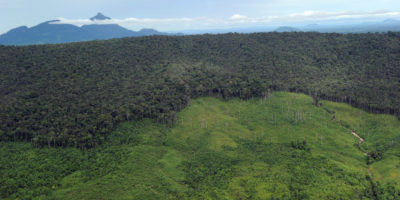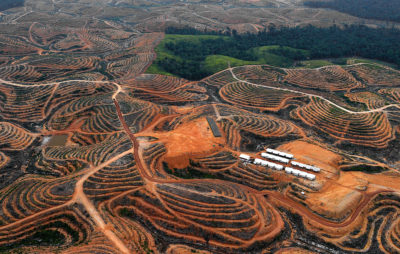Palm oil is the second-most important oil in the modern consumer society, after petroleum. Producing it is a $50-billion-a-year business. It’s in a multitude of the household products in North America, Europe, and Australia: margarine, toothpaste, shampoo, lipstick, cookies, Nutella, you name it. Doritos are saturated with palm oil. It’s what gives chocolate bars their appetizing sheen – otherwise, they would look like mud. Palm oil has replaced artery-clogging ghee as India’s main cooking oil. India is now the major consumer of this clear, tasteless oil squeezed from the nuts of the oil-palm tree, Elais guyanensis, originally from West Africa, but now grown pantropically, mainly within ten degrees north and south of the Equator.
Indonesia and Malaysia chose palm oil as their main economic engine after independence in the 1960s, and they together account for 85 percent of world production, which is expected to double by 2050. As oils go, palm oil gives you the best bang for your buck. Soy fields yield far less than rows of oil-palm trees and have to be replanted annually, while the palms keep bearing huge clusters of oil-rich nuts for 20 years, and can then be replaced. In 2015 17 million hectares of oil palm yielded a total of 62 million tons of oil, while the 120 million hectares planted in soy yielded 48 million tons. Palm oil doesn’t lose its properties when it’s heated, or become rancid at room temperature, and it has multiple industrial uses. It is the edible vegetable oil of choice and is not going away.
Borneo is ground zero for oil-palm devastation. Nowhere has more native rain forest been wiped out. The world’s third-largest island, Borneo’s lower 73 percent is in Indonesia— the territory of Kalimantan— and its upper portion consists of two states in Malaysia, Sarawak and Sabah, separated by the small, oil-rich sultanate of Brunei. Fifty percent of the lowland Borneo rain forest, which once covered all of the island up to 10,000 feet, is gone, but it’s still the third-largest in the world, after the Amazon and Equatorial Africa’s. It is part of the most ancient rain forest— forest, period— on earth: 130 million years old, more than twice as old as the Amazon’s, and has the greatest density of higher plant species, an estimated 15,000 flowering species. Each new botanical or entomological expedition comes back with new species. Some 20,000 insect species have been found in Sarawak’s Gunung Mulu National Park alone.
There are still hunter-gatherers on the island who hunt with blowguns and have 1,200 names for different trees.
Borneo is the world capital of dipterocarps, trees with two-winged fruits that grow in tropical lowlands and tend to be “emergents,” rising singly above the canopy. It has 380 of the 500 species in existence. 250 are endemic, found only on Borneo, including Shorea faguetana, the tallest tropical tree anywhere, reaching 290 feet. Ten of the emergent dipterocarp species have beautiful, hard wood and are sought after by the logging companies, most of which are Chinese. China is the main market now for lumber from Borneo. It used to be Japan.
Fantastic butterflies and moths, like the gigantic Rajah Brooke birdwing, have come into being in this primordial forest. And the Bornean wild pig, the Bornean pygmy elephant and pygmy rhinoceros, and Pongo pygmaeus, a different species of orangutan from the Sumatran. And orangutans are easy to have an interspecies experience with because they share 97 percent of our genes and are fantastic facial mimics.
Orphaned orangutan babies at the International Animal Rescue center on Borneo. BAY ISMOYO/AFP/GETTY IMAGES
There are still hunter-gatherers in the heart of the island who hunt with blowguns and leave 100 different signs of bent branches and folded leaves for each other in the forest and have 1,200 names for different trees and their corresponding spirits and until two generations ago believed that this is only one of nine different worlds in the cosmos. Every day throughout the year begins and ends with the six o’clock cicadas sounding off, and the haunting hoot choruses of the gibbons, and the fantastic arias of the bulbuls, and a riotous biophony of insects rattling and stridulating, and birds singing their hearts out.
The mountainous thickly jungled heart of Borneo was one of the last blank spots on the map, terra incognita, through World War II. The most remote bands of nomadic blowgun hunters were not reached by missionaries until the late l970s. Now they are all Christians and live in modern longhouses with TVs and electricity, but they still go off into the forest and hunt for days at a time, and a few bands still circulate in the forest and make new camps of raised pole huts every few weeks. Even the most isolated and traditional people in the central highlands are acutely aware of the modern world. Loggers are taking out their biggest trees, their rivers are being polluted and impounded by hydroelectric dams.
In the l950s, as synthetic rubber largely put an end to the natural rubber business, chainsaws and Caterpillar tractors arrived on Borneo. The following decade, the eradication of the rain forest began in earnest. First the commercial dipterocarps were felled and hauled out, then the remaining mangled forest was torched, a few days before rain was expected. But sometimes the rain didn’t come and the peat forest, with up to 20 feet of decomposing, combustible vegetable matter in its deep soil, would burn for months.
An area cleared for an oil palm plantation in Central Kalimantan province in Borneo. Bay Ismoyo/AFP/Getty Images
That is what happened in l997 when a pall of smoke from peat fires in Kalimantan, smothered southeast Asia and drifted east, all the way to Japan. That year, the peat fires released 2.5 billion tons of carbon. It happened again in 2003-4 and in 2015-6, when thousands of orangutans died of starvation and thousands of people in Kalimantan were hospitalized for smoke inhalation. Indonesia’s peat fires are a significant source of greenhouse gas emissions.
By the 1980s, the deforestation rate on Borneo was the highest on the planet, and in recorded history, and this continued into the new millenium. In the last 20 years the orangutans have lost 90 percent of their habitat. There are only maybe 30,000 left, and very little available forest left to release the ones in cages in care centers.
There’s a lot the individual consumer can do. Help Orangutan Foundation International acquire rain forest where it can release its hundreds of rescued orangutans. Support the Rainforest Action Network’s Conflict Palm Oil campaign to pressure the snack-food giants to commit to zero further deforestation or child or indentured labor on the concessions from which they source their palm oil. Nestle, Mars, Unilever, Cargill (the biggest consumer of palm oil in the United States), and other snack-food giants are on board, but PepsiCo continues to be a laggard, so boycott its products. Do without Doritos. Find out if palm oil is in the things you are eating and using— it has 19 aliases— and cut down on or eliminate your consumption of these products. Some 70 percent of what is labeled “vegetable oil” is palm oil.
Species continue to be wiped out before they are even discovered, the most tragic type of extinction.
The clearing and burning of peat forest has to be permanently banned. But on-the-ground verification that there is no further deforestation, that strips of forest have been left as wildlife corridors and along watercourses, is a huge problem, with all the corruption surrounding this lucrative commodity. Meanwhile species continue to be wiped out before they are even discovered, the most tragic type of extinction. Truly sustainable palm oil is still a long way off.
Support the investigations of the Bruno Manser Fonds, a Swiss NGO that has traced laundered profits from palm oil and logging in Sarawak from the former longtime chief minister and his family members and cronies to an upscale mall and condo complex in Ottawa, and a gated golf course community in the Arizona Desert. Keep abreast of the latest developments on Borneo and the spread of oil-palm cultivation around the Equator. The sad thing is that few modern consumers are aware of this far-away biocultural holocaust or of their complicity in it.
There have been some encouraging developments, particularly in Sarawak, which has elected a new chief minister, who is more supportive of the state’s 40-some ethnic groups and has canceled the massive Baram Dam. The 20,000 forest people who would have been displaced by its impounded water will have their land restored to them. Sarawak’s entire misguided, ecologically disastrous dam-building program has been canceled. But in Indonesia and Papua New Guinea, pristine rain forest continues to be annihilated. This is a global battle for the cultural diversity of the tropics. We have to keep the pressure on.





